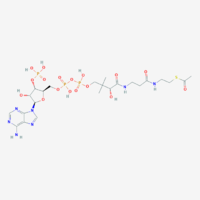Description
acetyl-CoA, C23H38N7O17P3S, is a central piece in metabolism. It can be synthetized in different pathways: (i) in glycolysis from pyruvate, by pyruvate dehydrogenase, which also forms NADH. (ii) from fatty acids β-oxidation, which releases one acetyl-CoA each round. (iii) catabolism of some aminoacids as leucine, lysine, phenylalanine, tyrosine and tryptophan.
Inside the mitochondria, acetyl-CoA is condensed with oxaloacetate to form citrate through the action of citrate synthase in tricarboxylic acid cycle. Acetyl-CoA cannot cross the mitochondrial inner membrane but citrate can be transported out of the mitochondria. In the cytosol, citrate can be converted to acetyl-CoA and be used in fatty acid, cholesterol, ketone bodies, acetylcholine synthesis, and other processes.
Reference: Gnaiger 2014 MitoPathways
Communicated by Cecatto Cristiane last update 2020-10-14
MitoPedia topics:
Substrate and metabolite

